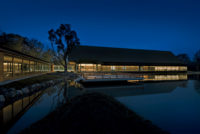Tokyo
Based in Tokyo but born in a rural town on the island of Shikoku, Hironaka Ogawa still draws inspiration from the countryside. Even as he starts to land bigger and more urban commissions, daylight, natural ventilation, greenery, and trees'the elements of his childhood landscape'continue to enrich his buildings.
For Ogawa, that perception began developing at a young age. His family home, built by his grandfather 90 years ago, is a large, wood-frame, Japanese-style house that blends with the scenery. 'There was no division between the building and its surroundings,' says Ogawa. 'It opens onto the garden that connects to the fields that extend out to the mountains.'
While Ogawa was growing up, Japan's 'bubble' economy was booming and new construction was everywhere. His tiny hometown was no exception. Lured by the smell of freshly sawn lumber and the candy tossed in celebration from newly mounted ridge beams, Ogawa was drawn to building. His mother, perceiving his interest, gave him a gentle push in that direction, too.
Ogawa left that charming setting for Nihon University in Tokyo, where he entered many conceptual competitions as an architecture student. One of his entries caught the attention of jurist Kengo Kuma, who invited the young architect to join his firm after graduation. Under Kuma's tutelage, Ogawa worked on residential, commercial, and institutional projects. His five-year stint culminated in the supervision of the Adobe Repository for a Buddhist Statue. On the grounds of Anyo-ji Temple in Yamaguchi prefecture, the earthen-brick enclosure exemplified Kuma's commitment to local materials and practices'an approach that resonates with Ogawa.
The experience of using mud bricks had an impact on Ogawa when he opened his own office in 2005 with a commission for the facade and interior of a Tokyo tonkatsu restaurant. Slathered with a thin layer of earth, the building front evokes traditional architecture and reads as a blank mud wall during the day. But at night, acrylic panels inset behind the surface emit glowing patches of light that animate the wall in a decidedly contemporary way.
Today, Ogawa's staff has grown to three. Located in a central Tokyo commercial district, the practice occupies a private office inside a communal workspace shared with five other design-related companies. An economical solution that provides young firms with a separate conference room and the all-important reception area for meetings with guests (a custom in Japan), shared offices are becoming increasingly common. 'With all these designers in one place, it is a very stimulating environment, full of energy,' Ogawa explains.
While headquartered in Tokyo, Ogawa works extensively on Shikoku, where he has already built numerous houses and has more work under way. Though it is easy to take design cues from the landscape in his native Kagawa prefecture, Ogawa seeks out ways to incorporate nature wherever he is, even when building in Tokyo. 'Trees aren't the only way to connect to nature,' he says. 'There is also light, wind, and rain.' A case in point, his Emblem House of 2008 is enclosed with a Kuma-style screen whose checkerboard motif, inspired by the client's family crest, softens the boundary between inside and out.
In a change from previous generations, Ogawa and his peers are demonstrating a growing interest in the surrounding scenery and a genuine concern for its wellness. 'When building anything, we have to demolish nature,' he laments. 'But there has to be a way to preserve the environment.'
Hironaka Ogawa & Associates
FOUNDED: 2005
DESIGN STAFF: 3
PRINCIPAL: Hironaka Ogawa
EDUCATION: Nihon University, M.Arch., 2000; B.Arch., 1998
WORK HISTORY: Kengo Kuma & Associates, 2000–05
KEY COMPLETED PROJECTS: Pleats.M, Saitama prefecture, Japan, 2012; Forest Chapel, Gunma prefecture, 2011; Chiyodanomori Dental Clinic, Gunma prefecture, 2011; Garden Tree House, Kagawa prefecture, 2010; Sundial House, Kagawa prefecture, 2009; Kimukatsu, Tokyo, 2006
KEY CURRENT PROJECTS: Bellows House, Kagawa prefecture, 2013; Pleats.I, Saitama prefecture, 2013
WEB SITE: www.ogaa.jp











Post a comment to this article
Report Abusive Comment